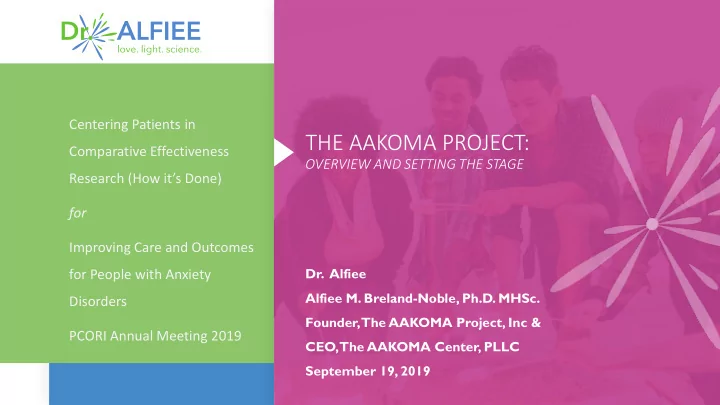

Centering Patients in THE AAKOMA PROJECT: Comparative Effectiveness OVERVIEW AND SETTING THE STAGE Research (How it’s Done) for Improving Care and Outcomes Dr. Alfiee for People with Anxiety Alfiee M. Breland-Noble, Ph.D. MHSc. Disorders Founder, The AAKOMA Project, Inc & PCORI Annual Meeting 2019 CEO, The AAKOMA Center, PLLC September 19, 2019
OUR GOALS: Why are we here? A) LEARN ABOUT REAL-WORLD, PATIENT-CENTERED RESEARCH COMPARING APPROACHES TO THE TREATMENT OF ANXIETY. B) DISCUSS THESE APPROACHES AND HOW THEY CAN IMPROVE THE TREATMENT OF ANXIETY FOR DIVERSE PATIENTS.
DISCLOSURES: Dr. Alfiee Breland-Noble 2018-2021 - PCORI INVESTIGATOR INITIATED AWARD (CO-INVESTIGATOR)
Your Moderator for today • Funded Clinical Investigator 20+ years • Mental Health Disparities Scientist • Depression and anxiety focus • African American/Black Youth and Youth of Color expertise • > 15 years academic medicine (Duke and Georgetown Psychiatry) • Mom • PoC Stakeholder with family history of anxiety
According to the ADAA Anxiety and Depression Association of America What We Know ( from research ) … • Anxiety disorders are the most common mental illness in the U.S., affecting 40 million adults in the United States age 18 and older, or 18.1% of the population every year. • Anxiety disorders are highly treatable, yet only 36.9% of those suffering receive treatment. • Per ADAA: Phobias, Social Anxiety Disorders, PTSD and Generalized Anxiety Disorders have highest prevalence.
Whose Experience of Anxiety are we missing? What We Need to Know… Most recent data we could find (specific to People of Color) is from 2010 (9 years ago)
Whose Experience of Anxiety are we missing? What We Need to Know… Most recent data we could find (specific to People of Color) is from 2010 (9 years ago) Growth Areas for Our Field: • Do People of Color conceptualize anxiety in the same way as Whites in the U.S.? • Do we understand have enough data on populations of people of color specific to anxiety disorders? • Why are PoC less likely to seek and obtain high quality care? • What are psychosocial barriers to the treatment of anxiety disorders for this population? • Hint: It is not insurance status or SES
How do we support care that addresses the needs of all patients? We will take a step in that direction via this panel today…
The AAKOMA Project THE AFRICAN AMERICAN KNOWLEDGE OPTIMIZED FOR MINDFULLY HEALTHY ADOLESCENTS PROJECT: OUR MISSION IS TO ADDRESS THE DEPRESSION AND OTHER MENTAL HEALTH NEEDS OF AFRICAN AMERICAN YOUTH AND OTHER YOUTH OF COLOR WE DO THIS THROUGH THE DEVELOPMENT AND IMPLEMENTATION OF RIGOROUS, CULTURALLY RELEVANT, PATIENT -CENTERED, COMMUNITY- ENGAGED RESEARCH AND CLINICAL CARE
Through the use of Community Based Participatory Research (CBPR) and traditional behavioral clinical trials, we develop culturally relevant interventions that inform: 1. The public about the unique mental health needs of African American and racially diverse youth (especially in the areas of depression and treatment engagement) 2. The mental health field about the unique perspectives of African American and racially diverse families regarding depression, treatment engagement and mental health disparities.
Spreading the Word…Research in Action
Mental Health Needs of People of Color
Barriers to Care Generally, mental health disparities for people of color exist in four areas: 1. Decreased access to/less availability of mental health services Includes issues with costs; insurance; availability of clinics and hospitals esp. for mental health concerns. 2. Lower likelihood of receiving required services As a result of abovementioned reasons; cultural stigma; failure to acknowledge mental health needs. 3. Experiences with poorer quality of care (Lack of cultural competence of providers and treatments; provider bias). 4. Underrepresentation in the field of mental health research Both in the role of participant and researcher.
PATIENT -CENTERED RESEARCH 14
Improving the Status Quo How can we improve provision of care and diminish the service provision gap across racial groups? Direct examination of current levels of knowledge and attitudes of youth of color surrounding the field of mental health many inform better practices. Means of reducing barriers to care and research involvement:
AAKOMA, CER & PCOR 16
Objectives of our Research
PCORI ENGAGEMENT AWARD 18
Engaging Black Faith Communities to Address Mental Health Disparities via Curriculum Development Goals of our EA Project: Build a network of African To evaluate and identify: To collaboratively develop a American youth patients, leaders, patient- and stakeholder-focused • Factors that help or hinder caregivers, parents, community training curriculum in PCOR, CER, FAITH BASED MENTAL members and other stakeholders and CBPR for African American HEALTH PROMOTION invested in developing skills in youth mental health. • Factors necessary to support PCOR and CBPR training in PCOR and CER
EA Project: Accomplishments Recruited a total of Primary Outcomes Engaged 15 FAITH 203 INDIVIDUALS • Curriculum COMMUNITIES Creation to participate in • Capacity Building survey completion across the project Community and • and group discussion period to create our Patient (with 17 focus groups stakeholder network Engagement completed)
Adult’s Youth’s Understanding Understanding of CER and of CER and PCOR PCOR
OUR FUNDED PCORI PIPELINE TO PROPOSAL (P2P) PROJECT 22
Building Capacity and Reducing Barriers to the Inclusion of Underserved Black Youth and Families for Behavioral and Mental Health Patient Centered Outcomes Research Our P2P project sought to develop a partnership between researchers, patient-partners, and stakeholders We work to build capacity for community partnerships to create research questions and submit PCOR research proposals
P2P Project: Current Status March 2018 Letter Spring 2018 INITIAL SCORE: STRONG WITH of Intent Addressing 41 MINOR ACCEPTED Disparities Grant WEAKNESSES
Future Research Additional factors Efficacy and that may prevent How to tailor effectiveness of youth of color from interventions to the culturally adapted engaging in mental needs and wishes of outpatient health research and patients of color psychotherapy clinical care Best practices for encouraging Culturally relevant engagement of this predictors of population and treatment among other youth effectiveness of color
Recommend
More recommend